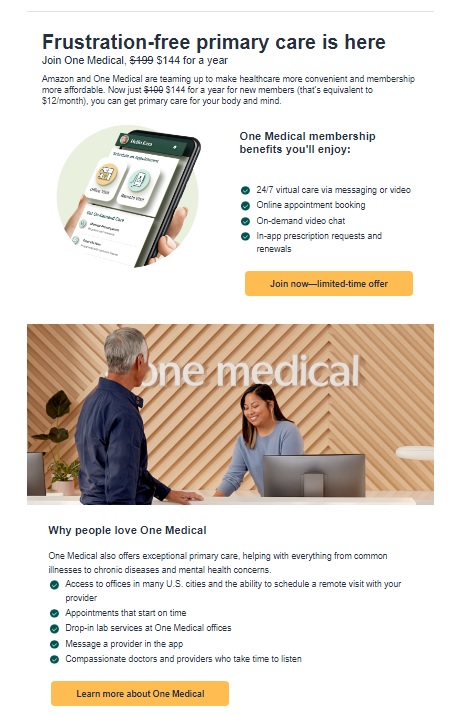 Cigna and Humana, perfect together? Only if they can get the deal through the Feds and the states. Late this week, the Wall Street Journal revealed that Cigna and Humana were exploring either a merger or, as some theorize, a buy of Humana ($93 billion in revenue, $60 billion valuation) by much-larger Cigna ($181 billion in revenue, $78 billion valuation). Between them, it is estimated that they would have 35 million members. No transaction cost has been estimated, but the WSJ sources indicate it will be a stock-and-cash deal that could be finalized by the end of the year if all goes well.
Cigna and Humana, perfect together? Only if they can get the deal through the Feds and the states. Late this week, the Wall Street Journal revealed that Cigna and Humana were exploring either a merger or, as some theorize, a buy of Humana ($93 billion in revenue, $60 billion valuation) by much-larger Cigna ($181 billion in revenue, $78 billion valuation). Between them, it is estimated that they would have 35 million members. No transaction cost has been estimated, but the WSJ sources indicate it will be a stock-and-cash deal that could be finalized by the end of the year if all goes well.
On paper, industry observers like it but point out the overlap in one significant area.
- Cigna earlier announced that it wants to sell its relatively small Medicare Advantage business, concentrating on its leadership in the commercial business and with its service businesses under the Evernorth umbrella.
- Humana is exiting its commercial health plans to focus on MA and Medicaid, as well as its large footprint in the home health business with CenterWell.
- Humana’s CEO Bruce Broussard is retiring next year, with newcomer to Humana Jim Rechtin joining as COO in January 2024 as his replacement. Cigna’s CEO David Cordani is a sprightly 57 and likely not to go anywhere.
- The overlap area that could be problematic is pharmacy benefit management (PBM) with each having about 17-18 million in Express Scripts (Cigna), the second largest in the US, and Humana Pharmacy Solutions.
Liking it on paper is one thing–FTC, DOJ, and 50 states may not feel so enthusiastic. It’s established through their actions that both Federal agencies are reining in M&A with new and restrictive merger guidelines scheduled to go into effect next year [TTA 20 July]. Healthcare is a major political hot button for this administration for cost–especially drug costs. That is where the reportedly equally sized in revenue PBM operations present the most major conflict to a merger or a buy, both in service and valuation. Both serve their own plan members as well as others, notably Express Scripts with 24% of claims, whereas Humana’s serves primarily its own plan members with 8% of claims. Neither are easy to divest without creating antitrust questions for acquirers and a major dent in Humana’s services. The final factor: Lina Khan, chair of the FTC, has never seen a merger that she’s liked based on her own statements [TTA 24 Aug].
Doomed to repeat history? In 2015, two payer mega-mergers involving these same companies were concocted: Cigna with Anthem and Humana with Aetna. They hit the buzzsaws of DOJ and before that, state approvals. The DOJ pursued them on antitrust in the Federal courts which derailed both by January 2017. Running up to that, every state got an approval vote through review by each state’s Department of Banking and Insurance or equivalent. Many did not approve or with conditions. The other factor is corporate. In the runup to the merger, Anthem-Cigna was marked by escalating animosity from the management suites to the worker cubes. After the deals were scuppered in the Federal District Court, Anthem and Cigna bitterly fought over damages and cancellation fees in Delaware Chancery Court. Aetna and Humana took their lumps and breakup fees, and went on. Aetna went on to merge with CVS, a deal that avoided most of the antitrust flak. Humana went on to acquisitions in other areas.
Our betting line. Both insurers will look at the financials in this hard-to-get-arrested year. Both will feel out the Feds before going forward. Both will calculate whether it’s best to start now or wait till next year and a possible change in administration. Neither company wants to be a political target in an election year. Defensively, Cigna may make noises about other combinations–Centene and Molina have been mentioned–which present their own difficulties and troubles, to strategically try to force the issue. Stay tuned! MedCityNews, Axios
Update: Other analysts suddenly are on board with this Editor’s gimlety view of the matchup, citing antitrust and how Federal regulators are primed to challenge major deals. The FTC is specifically probing the PBM business. The fact that the deal, according to JP Morgan, could take 12 to 24 months is no surprise as par for the course, but Mr. Market didn’t like it, dragging down both companies’ share prices every day since the rumor broke. (Hmmmm….do they read TTA?) But a small lamp was lit by one analyst: a Cigna-Humana combo could present real competition to the 9,000 lb. elephant of healthcare, UnitedHealth Group, and that might help to put it over. FierceHealthcare
Another concern that occurred to your Editor: Cigna’s international footprint could mean additional approvals by UK and EU regulators.
According to Healthcare Dive’s analysis, the combined entity would have a PBM market share of 32%, right up against CVS Health-Caremark at 33% and UHG’s OptumRx way behind at 22%. It’s a small group with big barriers to entry which makes it a slam-dunk to antitrust regulators. A whistle in the dark might be UHG’s long-drawn-out buy of Change Healthcare, but there were divestitures of business before closing and both parties managed to prove to the satisfaction of a US District Court that the separation to Optum Insight would not affect business relationships with other health plans. But here, both are health plans, and both have PBMs.
HIMSS 24 exhibitors, where are you? An item in today’s HIStalk on the ‘interesting’ choice as closing keynoter of football coach Nick Saban (U of Alabama Crimson Tide) at a healthcare IT conference went on to compare the number of booked HIMSS exhibitors to date with HIMSS 23’s floor total. This Editor, who for a few years booked the least expensive HIMSS space for the company she worked for back then well in advance, could not believe the low number of exhibitors three months from show time in March. Checking the HIMSS show website, there are 501 exhibitors listed. In 2023, according to HIStalk, there were 1,216. Many of these exhibitors have multiple booths in the Orange County (Orlando) Convention Center, but it still indicates the uncertain state of healthcare, pullbacks in marketing budgets, the rise of real competition in HLTH and ViVE, and perhaps some concerns about the show management transition from HIMSS itself to Informa. Are industry and IT influentials skipping HIMSS next year? Stay tuned or comment below!
 The other shoe just dropped. Walgreens Boots Alliance filed today (7 August) Form 8-K with the Securities and Exchange Commission (SEC) that confirms that they are considering a VillageMD sale. On page 2, Walgreens is considering the “sale of all or part of the VillageMD businesses, possible restructuring options and other strategic opportunities.”
The other shoe just dropped. Walgreens Boots Alliance filed today (7 August) Form 8-K with the Securities and Exchange Commission (SEC) that confirms that they are considering a VillageMD sale. On page 2, Walgreens is considering the “sale of all or part of the VillageMD businesses, possible restructuring options and other strategic opportunities.”











Most Recent Comments